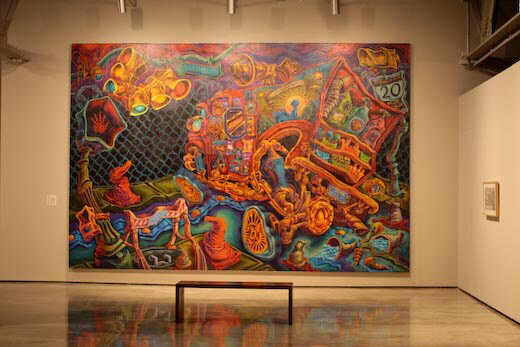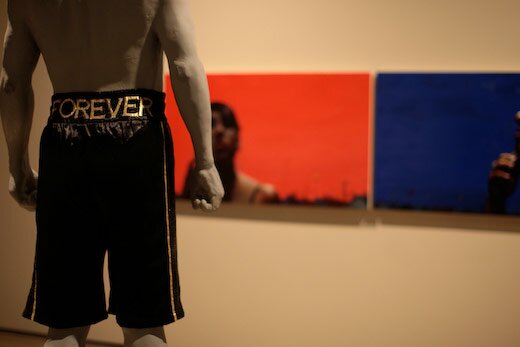Alex & Vincent
Posted by ben on 20 Dec 2007 at 05:39 pm | Tagged as: arts organizations, comics, graffiti, responses/reviews
I feel bad for Alex Rubio. A month after his residency at Artpace ended, he had to put together a whole new exhibition of work for Museo Alameda. And although he pulled it off, the differences between the shows are revealing. Both exhibits are based around the idea of community; at Artpace, Rubio orchestrated an installation that combined the talents of local artists ranging from graffiti artist Shek to metal sculptor Luis Guerrero to neon and glass artist Cathy Cunningham; the Alameda mounted a two-person show by Rubio and his former student Vincent Valdez, which emphasized their shared history in San Anto (Rubio on the west side, Valdez on the south side). The Alameda show also brought in some community artists to accentuate the work with neon and sculpture, but remained primarily a showcase of the two artists’ paintings.
Let me start off by saying that both shows were successful, and anyone who hasn’t seen them yet should make the effort to drop by Artpace and the Alameda before they go down (the Artpace show runs through January 6, while the Alameda show closes March 23). At Artpace, Rubio orchestrated an installation that seamlessly blends the talents of a wide range of artists into a work that fits right into Rubio’s oeuvre. Organizing a community of artists around a singular vision is no easy task, and Alex Rubio pulled it off.

The Museo Alameda’s exhibit, curated by Benito Huerta, has a different goal: to juxtapose the work of two San Antonio artists with common yet divergent paths. The reason this show works is that the cinematic drama of Vincent Valdez’s work provides an effective counterpoint to the twisted, psychedelic visions of Alex Rubio. Both artists embrace the gritty reality of the streets in their native barrios, and bring into full view both the pride and the laments of their cultural heritage. Yet the divergent means through which they approach these realities tinges the community they depict with two distinct flavors. Valdez’s aesthetic could be drawn from the films of Scorsese, with their visceral impact and complex, yet direct, realism. At the same time, Valdez weaves a contemporary symbolism into his work, imbuing it with a sense of cultural depth. Rubio, on the other hand, seems to owe more to the psychedelic exploration of underground comics or even rock concert posters, while bringing this stylistic vocabulary to a new level of complexity and vibrant energy.


But when your eye drifts from the paintings, the rough edges start to become apparent. A huge map of San Antonio reminiscent of a pirate treasure map is prominently installed in the exhibit, highlighting the artists’ neighborhoods and showing the locations of significant events in their lives. Besides being difficult to read, this map, when at long last it is deciphered, brings very little to the paintings, which clearly convey a coherent experience of the world. Neon hands designed by Valdez forming the “signs” for the North, South, East and West sides feel tacked on; and a sculpture of the boxer in Valdez’s paintings lacks the emotional depth and formal strength of the original.

Still, this show is about the paintings, and the paintings succeed.
Good review.
Q: Will the verse go on: He utilized technology (such as Flikr) to capture and archive it